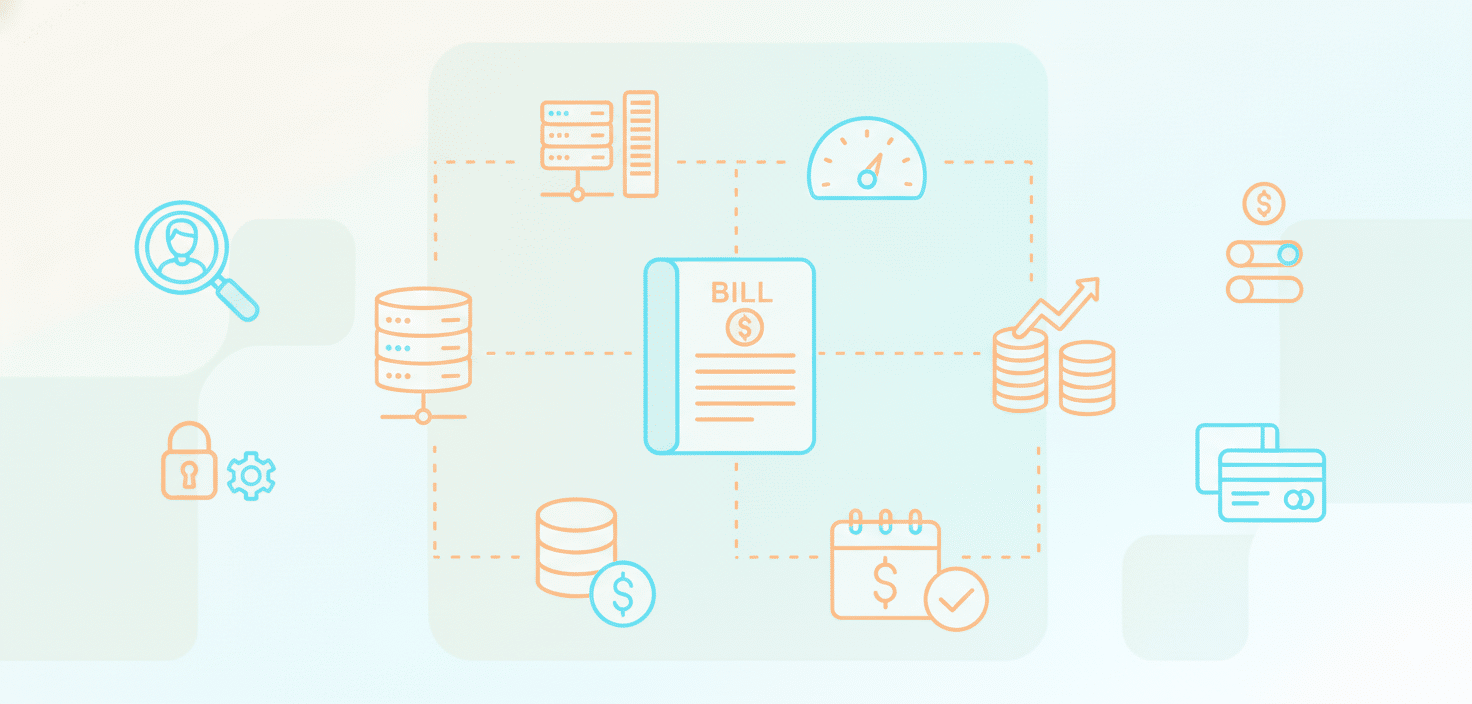SaaS-Zahlungen
Was ist dynamische SaaS-Abrechnung?

Was ist dynamische SaaS-Abrechnung?
SaaS Dynamic Billing ist eine Abrechnungsmethode, bei der die Preisgestaltung an die Parameter und das Verhalten der Kunden angepasst werden kann. Sie ermöglicht Preisanpassungen in Echtzeit, die sich potenziell auf die Umsatzgenerierung und die Kundenzufriedenheit auswirken.
Hauptmerkmale:
- Passt die Preise dynamisch an das Kundenverhalten oder die Nutzung an.
- Funktioniert mit diversen Preisstrategien, zum Beispiel:
- Nutzungsbasierte Modelle
- Wertbasierte Preisgestaltung
- Gestaffelte Preise
- Freemium-Modelle mit Add-ons
- Erfordert sorgfältige Planung und transparente Kommunikation, um:
- Kundenverwirrung zu vermeiden
- Vertrauen und Fairness wahren
Welche Vorteile bietet die dynamische SaaS-Abrechnung?
Die dynamische SaaS-Abrechnung bietet erhebliche Flexibilität und operative Vorteile, birgt aber auch einige Herausforderungen.
Vorteile:
- Das Preismodell ermöglicht es Kunden, nur für die verbrauchten Ressourcen zu bezahlen.
- Kostenüberlegungen gibt es sowohl für Kunden als auch für Anbieter.
- Eine transparente Abrechnung kann mit der Kundenzufriedenheit korrelieren.
- Einblicke in Nutzungsmuster und Verhalten können nützlich sein.
- Die Skalierbarkeit wird angepasst und die Abrechnung ändert sich je nach Nutzung.
- Automatisierung korreliert mit einem Rückgang manueller Arbeit und Ungenauigkeiten bei Abrechnungsprozessen.
- Abrechnungsprozesse zur Steigerung der Effizienz.
Herausforderungen:
- Die Implementierung kann komplex und technisch anspruchsvoll sein.
- Erfordert robuste Systeme zur Überwachung und Verwaltung von Nutzungsdaten.
- Eine unvorhersehbare Nutzung kann zu fluktuierenden Umsatzströmen führen.
Wie unterscheidet sich die dynamische SaaS-Abrechnung von herkömmlichen Methoden?
Die dynamische SaaS-Abrechnung spiegelt einen Wandel von der statischen Abrechnung zu einem datengesteuerten Preismodell wider.
|
Aspekt |
Dynamische Abrechnung |
Herkömmliche Abrechnung |
|
Preisstruktur |
Flexibel, passt sich je nach Nutzung oder Nachfrage an. |
Feste, statische Preisgestaltung |
|
Kundenwert-Ausrichtung |
Hoch – Preisgestaltung entspricht realem Verbrauch |
Niedrig – gleiche Kosten unabhängig von der Nutzung |
|
Umsatzpotenzial |
Optimiert durch Echtzeitanpassungen |
Eingeschränkt durch feste Tarife |
|
Automatisierungsgrad |
Hoch – automatisierte Rechnungsstellung und Zahlungen |
Oft manuelle Prozesse |
|
Komplexität |
Erfordert robuste Datenanalysesysteme |
Einfacher zu verwalten, aber weniger anpassungsfähig |
|
Risiko der Kundenwahrnehmung |
Erfordert Transparenz, um das Vertrauen zu wahren |
Vorhersehbar und stabil, weniger flexibel |
Was sind die Nachteile der dynamischen SaaS-Preisgestaltung?
Eine dynamische Preisgestaltung bietet zwar Flexibilität und potenzielles Umsatzwachstum, ist aber auch mit gewissen Risiken verbunden.
- Risiko von Kundenprotesten, wenn die Preise als unfair oder ausbeuterisch empfunden werden.
- Potenzial für Preiskämpfe, die die Gesamtgewinnmargen schmälern.
- Ungeeignet für Branchen, die eine stabile, vorhersehbare Preisgestaltung erfordern (z. B. lebenswichtige Güter, langfristige Verträge).
- Die Marktvolatilität kann die Vorhersage optimaler Preise erschweren, was zu entgangenen Umsatzchancen führt.
Welche Branchen profitieren am meisten von dynamischer SaaS-Abrechnung?
Dynamische Abrechnung ist ideal für Branchen mit variablen Verbrauchsmustern oder nutzungsbasierten Preismodellen.
- Eignet sich gut für Unternehmen jeder Größe — von Start-ups bis hin zu Großunternehmen.
- Besonders vorteilhaft in:
- Cloud-Computing (Abrechnung nach Speicher- oder Rechennutzung)
- Fluggesellschaften (dynamische Anpassung der Ticketpreise)
- Ride-Sharing-Dienste (Surge-Pricing bei hoher Nachfrage)
Unternehmen, die auf Echtzeit-Ressourcenverbrauch oder nutzungsbasierte Servicebereitstellung setzen.
Wie kann ich eine dynamische SaaS-Abrechnung effektiv implementieren?
Hier sind die zu befolgenden Schritte:
- Ziele definieren:
- Umsatz steigern
- Verbessern Kundenzufriedenheit
- Abrechnungsprozesse vereinfachen
2) Bestehende Abrechnungssysteme prüfen:
- Lücken oder Integrationspunkte identifizieren.
3) Anbieter für dynamische Abrechnungssoftware auswählen:
- Achten Sie auf Unterstützung für:
- Nutzungsbasierte Preisgestaltung
- Abrechnungsanpassungen in Echtzeit
- Leistungsstarkes Reporting und Analysen
4) Beispiel:
- Ein SaaS-Unternehmen rechnet mit Kunden ab, basierend auf:
- Anzahl aktiver Nutzer
- Der verbrauchten Datenmenge
- Rechnungen werden je nach Nutzung automatisch aktualisiert.
5) Teams schulen:
- Bieten Sie umfassende Schulungen und kontinuierlichen Support, um eine effektive Verwaltung zu gewährleisten.
Wie kann die dynamische SaaS-Abrechnung die Kundenbindung verbessern?
Verbesserungen durch dynamische SaaS-Abrechnung Kundenbindung:
- Bietet maßgeschneiderte Abrechnungsoptionen, die die tatsächliche Nutzung widerspiegeln.
- Steigert die Kundenzufriedenheit durch:
- Genaue, transparente Rechnungen
- Faire und individualisierte Preisgestaltung
- Reduziert die Kundenabwanderung durch datengesteuerte Kundenbindungskampagnen.
- Nutzen Sie Analysen, um:
- das Kundenverhalten zu verstehen
- Abrechnungsstrategien anzupassen
- das Kundenerlebnis kontinuierlich zu verbessern
Schlussfolgerung
Die dynamische SaaS-Abrechnung verknüpft die SaaS-Preisgestaltung potenziell mit dem wahrgenommenen Wert, was sich je nach strategischer und klarer Umsetzung auf Umsatz und Kundenzufriedenheit auswirken kann.